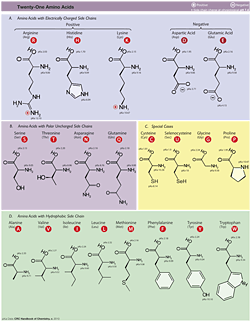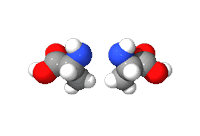Protein Parts

Just like a Lego house is made of bricks, proteins are made up of lots of tiny building blocks. These building blocks are called amino acids.
To build a protein, first the amino acids are connected into long chains. These chains of amino acid building blocks can then fold into all types of shapes. Some chains fold into spirals. Other chains make zigzag sheets, and loops.
Combining these spirals, sheets, and loops is how the three-dimensional shape of the protein is made. You can also combine multiple strands of amino acids to make even bigger protein shapes.
21 Is All It Takes
The human body uses just 21 amino acids to make all the proteins it needs to function and grow. Because amino acids can be arranged in many different combinations, it's possible for your body to make thousands of different kinds of proteins from just the same 21 amino acids. You may see books that say there are only 20 amino acids. Don't worry, that's just because the 21st one was discovered pretty recently and not all the books have caught up yet.

Essential Amino Acids
There are nine amino acids that your body can’t make. They are called essential amino acids, meaning you must have them to live. They are found in foods like milk, eggs and meat and also a wide variety of plants. This is part of why you can’t survive on a diet of just corn chips for very long. Essential amino acids were actually discovered in an experiment testing something very similar to a "corn chip diet".
Scientists fed rats a diet that had only corn protein in it and observed the results. What they noticed was that rats on this diet got sick and would eventually die. When the sick rats were fed protein from milk, however, they would get better. This told the scientists that something in milk protein was essential to health of rats, that it was something they couldn't live without.
Where Do Amino Acids Come From?

Just like a Lego house built with Lego bricks can be taken apart, and the bricks used to build something completely different (like a really cool T-Rex), your body can take apart the amino acid building blocks that make up protein and re-use these to make new, totally different proteins. Even your body knows that recycling is really cool!
But where do these amino acid building blocks come from? As it turns out, your cells can make most of the amino acids it needs from other molecules in your body. Nine of these amino acids it can’t make though, so you have to get these from the food you eat. Otherwise, it would be like a Lego set missing nine kinds of bricks to be a complete set. There are certain things you just couldn't build without the missing building blocks.
Read more about: Venom!
Bibliographic details:
- Article: Protein Parts
- Author(s): Dr. Biology
- Publisher: Arizona State University School of Life Sciences Ask A Biologist
- Site name: ASU - Ask A Biologist
- Date published:
- Date accessed:
- Link: https://askabiologist.asu.edu/venom/building-blocks-protein
APA Style
Dr. Biology. (). Protein Parts. ASU - Ask A Biologist. Retrieved from https://askabiologist.asu.edu/venom/building-blocks-protein
Chicago Manual of Style
Dr. Biology. "Protein Parts". ASU - Ask A Biologist. . https://askabiologist.asu.edu/venom/building-blocks-protein
Dr. Biology. "Protein Parts". ASU - Ask A Biologist. . ASU - Ask A Biologist, Web. https://askabiologist.asu.edu/venom/building-blocks-protein
MLA 2017 Style
Be Part of
Ask A Biologist
By volunteering, or simply sending us feedback on the site. Scientists, teachers, writers, illustrators, and translators are all important to the program. If you are interested in helping with the website we have a Volunteers page to get the process started.


